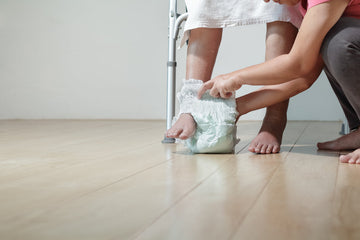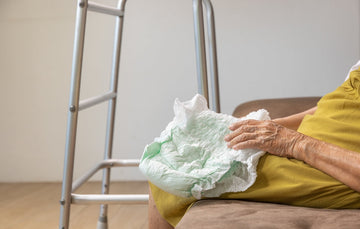Adult diaper rash, also known as diaper dermatitis, is caused by irritation of the skin around the diaper area. It usually appears as a rash with patches of inflamed red or pink skin, with tiny bumps on occasion. This diaper rash in adults is normally treatable with the help of home remedies or natural oils-containing products. These symptoms can sometimes worsen to the point of becoming painful when irritation occurs in the groin, buttocks, thighs, hips, and the genital area around the diaper. Even if it's a minor irritant, it can cause serious discomfort and make walking, wearing certain clothing, and going about your everyday activities difficult.
A rash can appear from a variety of causes, and determining the origin of the rash is crucial for diaper rash treatment. The following are the most common types of diaper rash in adults:
1. Irritant contact dermatitis
Irritant contact dermatitis is the most common type of diaper rash in adults. It occurs when the skin is irritated by something in the diaper, or sometimes the diaper itself.
When a person sits in a wet or soiled diaper for an extended amount of time, this type of dermatitis worsens.
Irritant contact dermatitis can leave you with red pimples or patches on your skin. There may also be welts that crack open and bleed if the condition is serious enough. Fungi and bacteria can easily enter the skin through open sores, raising the risk of a subsequent infection. Irritant contact dermatitis can be treated by changing the person's diaper more regularly and using an adult diaper rash treatment until the rash disappears and thereafter it can be prevented by using silicone-based barrier products.
2. Candidiasis or yeast infections
Candida is a fungus that generally lives on the skin and in the diaper area. When they overgrow, they can cause candidiasis, or a yeast infection, which is a severe diaper rash.
The rash may seem red and inflammatory, with white, fluid-filled blisters or large patches covered in a white, scaly covering. Following a severe diaper rash that cracks open and bleeds, a person may get a yeast infection. Some yeast infection rashes can be treated with a diaper rash cream for adults. It is also critical to maintaining a clean and dry environment.
3. Intertrigo
Intertrigo is an inflammatory skin ailment that is more severe in skin folds and warm, moist areas, such as a person's thighs or buttocks. Intertrigo occasionally develops secondary yeast or bacterial infections that necessitate further treatment. Intertrigo diaper rashes can lead to other inflammatory rashes in adults. In most circumstances, intertrigo can be controlled by removing the source of irritation. This usually entails more frequent diaper changes for seniors. Intertrigo can be treated or prevented using silicone-based barrier gels.
4. Eczema
Eczema can create sores around the diaper area. The skin appears to be dry and inflamed, which the caregiver may notice. Red spots or scaly areas of skin are possible. Eczema affects other parts of the body in many adults. It's unusual for it to happen solely in the diaper area.
While moisturizing the area can help relieve eczema, it can also keep the diaper area moist, raising the risk of other types of diaper rash. Depending on the severity of eczema, a physician may prescribe a steroid cream or another treatment.
5. Bacterial skin infections
Red, puffy, and irritated skin can result from bacterial infections in the diaper area. These infections could spread to other parts of the body and become life-threatening if not treated. Adults who are infected with bacteria may develop a fever or appear ill. Some people, on the other hand, may have no other symptoms than a diaper rash. A doctor usually prescribes antibiotics. Because bacterial infections can enter the body through open sores caused by diaper rash, preventing diaper rash may also help to avoid subsequent infections.

Adult Diaper Rash Prevention Tips
Changing briefs frequently and as soon as they get wet or soiled is the best method to avoid diaper rash.
Washing the entire region with a mild cleanser or mild soap daily can also help to decrease inflammation. Before putting on a new diaper or applying bum rash cream for adults, thoroughly dry the person's diaper area.
Applying adult diaper rash cream or medicated lotions to inflamed skin before putting on briefs or pads can also assist to reduce incidences of diaper rashes.
Read also, How to avoid diaper rash in adults?
Outlook
With proper cleanliness and the usage of adult diaper rash treatment, most cases of adult diaper rash are cleared up in 2-3 days. A person should contact a doctor if a diaper rash does not improve with basic hygiene and adult diaper rash ointments. If a rash is severe or lasts more than three days, people should seek medical help. Severe diaper rashes and those caused by underlying medical disorders, on the other hand, almost always necessitate treatment to avoid irreversible skin damage and other health problems.




